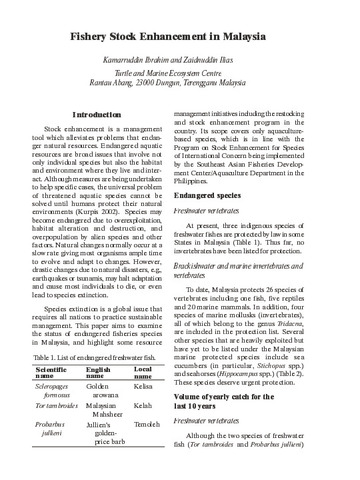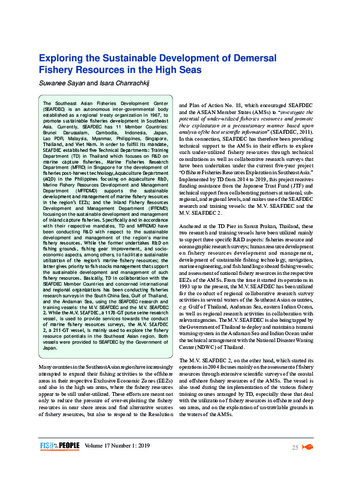Status of Fishing Conditions in Japan in Relation to Responsible Fisheries
Share
ບົດຄັດຫຍໍ້
The presence of a large number of species that are low in quantity in Japan's coastal waters has resulted in the evolution of a food culture that has historically utilized most of the catch species and sizes that are caught in coastal trawls. This has resulted in a diverse range of species and sizes captured and amounts to 40% of total animal protein intake. Sustainable fisheries in Japan are necessary for preserving food culture as well as employment and income and great efforts are being made to conserve resources. Three strategies have been carried on for conservation of fisheries in Japan, are (1) Enhancement of Fish stocks, (2) Improvement of fishing grounds and (3) Improving the selectivity of fishing gears. Increasing mesh size and release of fish juveniles after capture has already been accepted by fishers. Fishers and scientists together have become a team in developing and testing selective fishing gears. Selectivity has been investigated on a practical basis with the aim to reduce fish discards and to release fish juveniles. However, unlike many western countries, guiding net panels and grids to improve selectivity have not been successful in Japanese coastal multi-species fisheries. The variations in size, shape, price and seasonally of species make development of selective fishing gears extremely complex. Our practical target is to promote live capture technology, improve utilization of species captured and refine catch records for investigation of fish stocks.
Suggested Citation
Inoue, Y., & Chopin, F. (1997). Status of fishing conditions in Japan in relation to responsible fisheries. In Proceeding of the Regional Workshop on Responsible Fishing, Bangkok, Thailand, 24-27 June 1997 (pp. 87-99). Samut Prakarn, Thailand: Training Department, Southeast Asian Fisheries Development Center.
ວິຊາ
commercial species  ; underutilized species
; underutilized species  ; coastal fisheries
; coastal fisheries  ; marine fisheries
; marine fisheries  ; fisheries development
; fisheries development  ; fishery management
; fishery management  ; fishing
; fishing  ; sustainable fishing
; sustainable fishing  ; sustainability
; sustainability  ; fishery resources
; fishery resources  ; trawling
; trawling  ; stock assessment
; stock assessment  ; stocking (organisms)
; stocking (organisms)  ; stocks
; stocks  ; fishing grounds
; fishing grounds  ; fishing gear
; fishing gear  ; gear selectivity
; gear selectivity  ; fishers
; fishers  ; Japan
; Japan
 ; underutilized species
; underutilized species  ; coastal fisheries
; coastal fisheries  ; marine fisheries
; marine fisheries  ; fisheries development
; fisheries development  ; fishery management
; fishery management  ; fishing
; fishing  ; sustainable fishing
; sustainable fishing  ; sustainability
; sustainability  ; fishery resources
; fishery resources  ; trawling
; trawling  ; stock assessment
; stock assessment  ; stocking (organisms)
; stocking (organisms)  ; stocks
; stocks  ; fishing grounds
; fishing grounds  ; fishing gear
; fishing gear  ; gear selectivity
; gear selectivity  ; fishers
; fishers  ; Japan
; Japan
Related items
Showing items related by title, author, creator and subject.
-
Current Status of Fish Stock Enhancement in Thailand
Ingthamjitr, Suchart; Sricharoendham, Boonsong (Training Department, Southeast Asian Fisheries Development Center, 2016)Aquatic animals from natural waters have long been exploited by rural poor as cheap protein food. Natural waters including rivers, canals, swamps, lakes, large reservoirs, and small water bodies are significantly exploited ... -
Fishery stock enhancement in Malaysia
Ibrahim, Kamarruddin; Ilias, Zaidnuddin (Aquaculture Department, Southeast Asian Fisheries Development Center, 2006)Species extinction is a global issue that requires all nations to practice sustainable management. This paper aims to examine the status of endangered fisheries species in Malaysia, and highlight some resource management ... -
Exploring the sustainable development of demersal fishery resources in the high seas
Sayan, Suwanee; Chanrachkij, Isara (Secretariat, Southeast Asian Fisheries Development Center, 2019)The Southeast Asian Fisheries Development Center (SEAFDEC) is an autonomous inter-governmental body established as a regional treaty organization in 1967, to promote sustainable fisheries development in Southeast Asia. ...




